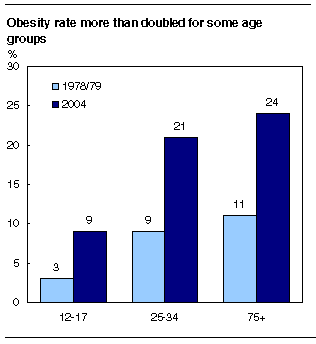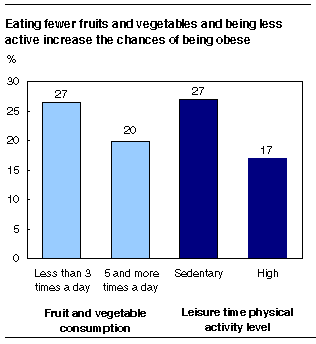
















 |
|
 |                |
Information identified as archived is provided for reference, research or recordkeeping purposes. It is not subject to the Government of Canada Web Standards and has not been altered or updated since it was archived. Please "contact us" to request a format other than those available.

|

Wednesday, July 6, 2005 Canadian Community Health Survey: Obesity among children and adults2004Obesity rates among children and adults have increased substantially during the past 25 years, according to new results from the Canadian Community Health Survey (CCHS), which directly measured the height and weight of respondents. 
In 1978/79, 3% of children aged 2 to 17 were obese. By 2004, 8%, or an estimated 500,000 children, were obese. Among adults, the growth in obesity was even more dramatic. In 1978/79, the age-adjusted adult obesity rate was 14%. A quarter century later, 5.5 million individuals, representing 23% of adults, were obese.
Among young people, the biggest increases in obesity rates over the past 25 years occurred among adolescents aged 12 to 17, where the rate tripled from 3% to 9%. For adults, the most striking upturns occurred among people who were aged 25 to 34, and those who were 75 or older where the rates more than doubled to 21% and 24% respectively. Even so, Canada's adult obesity rate was significantly lower than that in the United States. While 23% of Canadian adults were obese in 2004, the rate was nearly 30% south of the border. Overweight and obesity rates were calculated using the body mass index (BMI), which is calculated by dividing weight in kilograms by height in metres squared. For adults, a BMI of 25 or more indicates overweight and an increased risk of developing health problems; 30 or more indicates obesity and a high to extremely high risk of developing health problems. For example, an adult male who is 1.8 metres tall (five feet, 10 inches) and weighs 95 kg (210 pounds) would have a BMI of 30 and be considered obese. Similarly an adult female who is 1.6 metres tall (five feet, 4 inches) and weighs 80 kg (175 pounds) would have a BMI of 30 and also be considered obese. BMI is calculated using the same formula for children and adolescents. However, the cut-points for being overweight and obese vary by the age and sex of the child. Notable increase in obesity among adolescentsIncreases in overweight and obesity were similar among boys and girls. However, trends differed for various age groups. For example, the proportion of children aged two to five who were either overweight or obese remained virtually unchanged from 1978 to 2004. In contrast, the overweight/obesity rate of adolescents aged 12 to 17 more than doubled from 14% to 29%, while their obesity rate alone tripled from 3% to 9%. This upturn among adolescents is of particular concern because overweight or obese conditions in adolescence often persist into adulthood. Rates of overweight and obesity among youth varied across the country, with the highest rates being in the Atlantic provinces. In 2004, the combined overweight/obesity rate of young people aged 2 to 17 was significantly above the national level in Newfoundland and Labrador, New Brunswick, Nova Scotia and Manitoba. The combined rate was significantly below the national level in Quebec and Alberta The prevalence of obesity was significantly higher than the national average in Newfoundland and Labrador and New Brunswick. Overweight and obesity rates of Canadian and American boys did not differ significantly. However, Canadian adolescent girls were significantly less likely than their American counterparts to be obese. According to CCHS data, children and adolescents who reported eating fruits and vegetables five or more times a day were substantially less likely to be overweight or obese than those who consumed them less frequently. About 4 in 10 children and adolescents (41%) reported that they ate fruit and vegetables five times a day or more. The survey also found that among children aged 6 to 17, the likelihood of being overweight or obese tended to rise with time spent watching TV, playing video games or using the computer. Adults: Obesity rates up in almost every age groupDuring the past 25 years, obesity rates rose for every age group among adults except those 65 to 74. The most striking upturns were among people younger than 35 and those 75 or older. For instance, the proportion of adults aged 25 to 34 who were obese more than doubled from 9% to 21%. Similarly, the rate among people aged 75 or older rose from 11% to 24%. In 2004, men and women were equally likely to be obese. However, both the World Health Organizations (WHO) and Health Canada divide obesity into three categories of severity. A higher percentage of women than men were in the most severe class where the risk of developing health problems is considered extremely high. For both sexes, obesity rates were lowest, around 11%, for those aged 18 to 24. They peaked around 30% among individuals aged 45 to 64. About one-quarter of seniors were obese. With a few notable exceptions, adult obesity rates did not vary greatly by province. In 2004, the rate for men was significantly above the national level in Newfoundland and Labrador and Manitoba. The rate for women surpassed the national figure in Newfoundland and Labrador, Nova Scotia and Saskatchewan. Large differences between Canadian and American womenOver the past decade Canada's obesity rates have been based on self-reported data, whereas the United States has derived rates from actual measurements of height and weight since the early 1960s. With the measured data from the 2004 CCHS, it is possible to compare the current prevalence of obesity in the two countries. Age-standardized results show that 30% of Americans aged 18 or older were obese in 1999/2002, significantly above the Canadian rate of 23%. Most of this difference was attributable to the situation among women. While 23% of Canadian women were obese, the figure for American women was 33%. 
Lifestyle factors: Diet, physical activity and income play a roleAs might be expected, the likelihood of being obese was related to diet and exercise. Adult men and women who ate fruit and vegetables less than three times a day were more likely to be obese than were those who consumed such foods five or more times a day. Although other factors may be driving this relationship, the association persisted when age and socio-economic status were taken into account. However, because the CCHS data are cross-sectional, the causality of this relationship cannot be determined. Physical activity, too, was related to the prevalence of obesity. People who spent their leisure time in sedentary pursuits were more likely than those who were physically active to be obese. For example, 27% of sedentary men were obese, compared with 20% of active men. Among women, obesity rates were high not only for those who were sedentary, but also for those who were moderately active. These relationships remained statistically significant when adjustments were made to account for age and socio-economic status. 
Socio-economic factors such as marital status, education and income also influenced an individual's chances of being obese. For example, men living in higher income households tended to have higher chances of being obese. Meanwhile, women coming from middle income households had higher levels of obesity. Definitions, data sources and methods: survey number 5049. This release is based on two articles Adult Obesity in Canada: Measured Height and Weight and Overweight Canadian Children and Youth, which are now available for free online (82-620-MWE2005001). These articles are the first to be released in the Internet publication Nutrition: Findings from the Canadian Community Health Survey (82-620-MWE, free). For more information, contact Media Relations (613-951-4636), Communications and Library Services Division. |
|
|
|